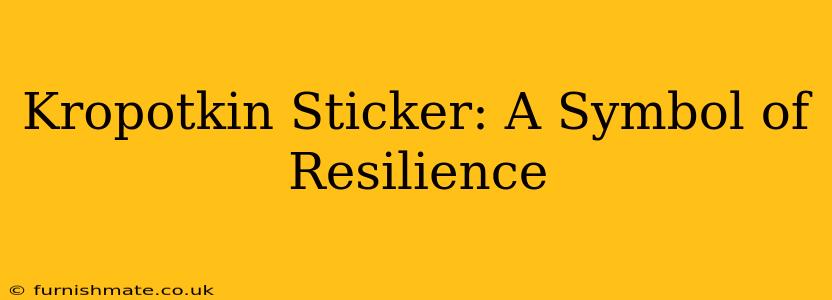Peter Kropotkin. The name itself evokes images of revolution, anarchism, and mutual aid. But for many today, Kropotkin's legacy isn't just found in academic texts; it's also visible on a small, often overlooked symbol: the Kropotkin sticker. These stickers, appearing on laptops, skateboards, and even protest signs, represent more than just a political affiliation; they're a testament to a philosophy of resilience, mutual support, and a rejection of hierarchical power structures. This article will delve into the meaning and significance of the Kropotkin sticker, exploring its evolution and the underlying ideology it represents.
What Does a Kropotkin Sticker Represent?
The Kropotkin sticker, typically featuring a portrait of the Russian prince-turned-anarchist, serves as a visual shorthand for a complex set of beliefs. At its core, it symbolizes anarchism, specifically a branch that emphasizes mutual aid and cooperation over competition and domination. Kropotkin's work, particularly "Mutual Aid: A Factor of Evolution," highlights the crucial role of cooperation in the natural world and human societies. The sticker, therefore, becomes a declaration of solidarity with this philosophy—a belief in collective action, self-governance, and the rejection of oppressive systems.
Why Do People Put Kropotkin Stickers on Their Belongings?
People choose to display Kropotkin stickers for a variety of reasons, often intertwining personal beliefs and political statements. It’s a way to:
- Express political beliefs: For some, it's a clear and concise way to signal their anarchist or anti-authoritarian leanings. In a world dominated by hierarchical structures, the sticker acts as a subtle form of rebellion.
- Show solidarity with a specific philosophy: The sticker represents support for Kropotkin's ideas about mutual aid and the importance of community-based solutions to social problems.
- Connect with a community: Displaying the sticker can be a way to connect with like-minded individuals, fostering a sense of belonging and shared values.
- Start conversations: The sticker can act as a conversation starter, prompting discussions about anarchism, social justice, and alternative ways of organizing society.
Is a Kropotkin Sticker a Symbol of Rebellion?
Yes, absolutely. The Kropotkin sticker can be seen as a symbol of rebellion against established power structures and oppressive systems. It represents a rejection of the status quo and a desire for a more equitable and just society. However, it's important to note that this rebellion is often expressed through non-violent means, reflecting Kropotkin's commitment to peaceful revolution and mutual aid.
What are the Different Types of Kropotkin Stickers?
While the most common Kropotkin sticker features a portrait of the man himself, variations exist. Some might include quotes from his work, stylized imagery related to nature or mutual aid, or incorporate other anarchist symbols. The design often reflects the individual's interpretation of Kropotkin's philosophy and their personal aesthetic.
What is the History of the Kropotkin Sticker?
Tracing the exact origins of the Kropotkin sticker is difficult. However, its rise in popularity correlates with the increased visibility of anarchist and anti-authoritarian movements, particularly online. The ease of creating and distributing stickers through online print-on-demand services and social media has contributed to its widespread adoption. It’s a low-cost, easily accessible way to express political sentiment.
Conclusion: More Than Just a Sticker
The Kropotkin sticker is more than just a piece of adhesive paper; it's a powerful symbol of resilience, mutual aid, and a commitment to building a better world. It represents a philosophy that challenges dominant power structures and encourages cooperation and collective action. Its presence, whether on a laptop or a protest sign, serves as a reminder of the enduring relevance of Kropotkin's ideas and the ongoing struggle for social justice. The small sticker carries a significant message, quietly proclaiming a belief in a different, more equitable future.

